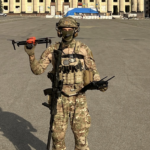In the first phase of the Russia-Ukraine conflict, the focus was on hardware – the natural reflex being to counter mass with more mass. Ukraine received much-needed vehicles and weapons along with intelligence products. As Western aid reduced domestic inventory and stockpiles, nations announced increases to defence budgets to procure replacement artillery pieces, tanks, air defence assets, and ammunition — conventional warfighting equipment. But what of the software that underpins the hardware? What role does AI play?
Eighteen months later, we have learned an important lesson: mass remains important. But it is through digitised and networked forces that Ukraine, although largely improvised, has managed to counter the Russian attack. Software systems such as GIS Arta, Delta and Kropyva have allowed Ukraine to carefully marshal its resources across large and geographically disconnected fronts. In this way, Ukraine has achieved local numerical superiority at a place and time of a commander’s choosing – significantly enhancing both lethality and survivability at the tactical level. In some cases, software has amplified Ukrainian mass and allowed them to be successful even when outnumbered 12:1.
Conversely, the recent counter-offensive has shown that an analogue approach to the integration of assets is slow and largely ineffective.
In short, we have seen how dominance in information, and thus speed and precision, can win over dominance in numbers. Equally, recent examples from the Ukrainian counter-offensive show that The West needs to dominate software and AI if it wants to keep the upper hand in defending its democratic values and way of life.
There are four key observations from Ukraine that illustrate this point:
- Speed x Mass: functional chains that link any sensor with the most apt decision maker and the best effector must be closed as quickly as possible. These functional chains must be able to interact with multiple hardware systems on the one hand and efficiently match dislocated targets with the best effectors on the other. The Kropyva application and other domestically produced C2 software used by the Armed Forces of Ukraine is a case in point: sensors and effectors can be integrated, significantly reducing targeting cycles. Without this, Ukraine would be hard-pressed to counter Russia’s artillery dominance.
- Adaptability is key: every measure will lead to a countermeasure. The Russian armed forces are continuously developing their capabilities and adapting to tactical conditions, forcing Ukraine to respond in kind. GIS Arta was developed in response to Russian artillery in 2014/15, for example. This cycle is not new, nor is it unique to Ukraine, so it follows that adaptive capabilities are needed to respond to emerging threats and environments.
- Software transforms efficiency: Indirect fires play a critical role in Ukraine’s defence. UAV-guided indirect fire has allowed targeting cycles to be significantly accelerated. It has also led to improvements in the precision and efficiency of dumb artillery by improving the quality of target coordinates. In Ukraine, this is enabled through software that directly connects UAV operators to indirect fire systems. Once long and error-prone processes are now completed in near real-time. The result is faster artillery strikes with fewer rounds to effect, therefore, more efficient use of munitions. This is crucial in the current state of war, where efficiency compensates for a lack of munitions.
- There is a new defence ecosystem that builds these capabilities: on the Ukrainian side, but also in Western support for Ukraine, new companies in the defence and security industry are making a significant contribution to the country’s defence. Digital technologies are advancing at a relentless pace and require new types of partnerships where original equipment manufacturers collaborate with software and AI companies to deliver new software-defined capabilities.
Today, the British Army sends information back from battlefield sensors to central hubs where it is processed and analysed. This is an imperfect procedure hindered by disrupted network infrastructure and constrained bandwidth. AI enables much of this information to be processed and analysed at the point of collection. It can then be fused into a single operational picture and distributed to the relevant forces. It enables mission command at the tactical level whilst ensuring that resources can be allocated at the operational and strategic levels in real time – extending the reach, lethality, and survivability of tactical units.
Speed, mass, and precision are required in all aspects of Land warfare, from reconnaissance to decision-making through to the delivery of effects. Ukraine has demonstrated how this combination of ingredients is vital in achieving combat advantage. It stands to reason that software-defined functional chains, enabled by AI, should be a non-negotiable component in empowering the British Army to deter and defend against peer opponents. It is no longer the large eating the small, but the fast eating the slow.

Mike Wilmot
Mike Wilmot is the Land domain lead at Helsing UK. He is a former McKinsey & Co. consultant and served 12 years in the British Army.
Helsing is a new type of defence company, focusing on developing software-based capabilities to protect our democracies.


